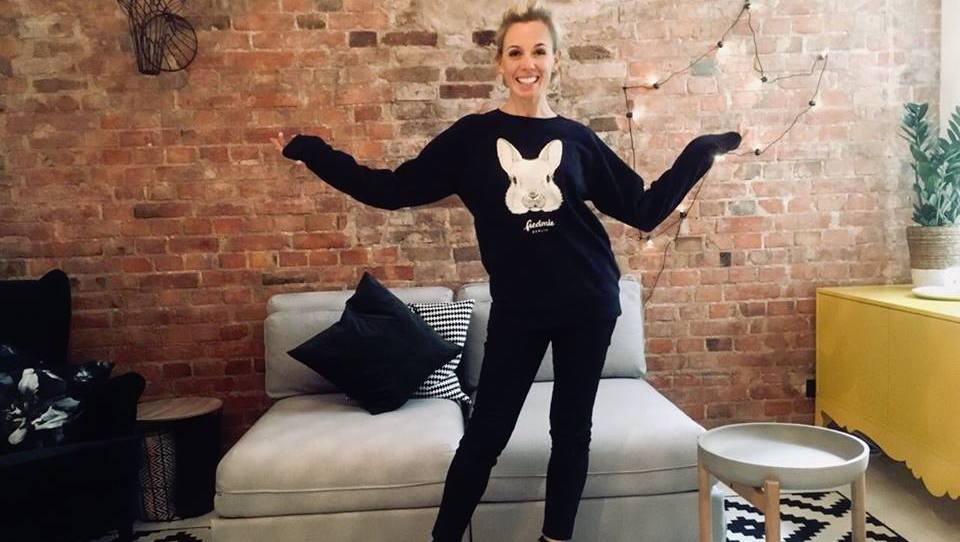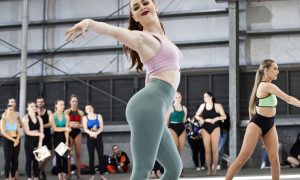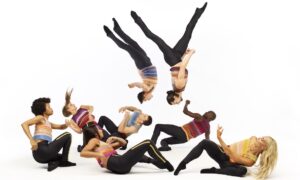Have you ever been embarrassed to admit that you work a side job — that dancing doesn’t always pay enough to cover your rent, bills and pay off your student loans…let alone to go on a shopping spree or a night at the movies with your friends? Having a side hustle is nothing to be ashamed about since it can help you to actually have the stability to do what you love — dance! It can help you pay for dance classes, a gym membership and voice lessons. It provides some security in case you get injured and can’t rely on your physical dancing body to earn your income. And it can also provide you with a community of friends outside of the performing arts. One might argue that working a side gig apart from dance is actually healthy for your mind, body and spirit.
But a lot of dancers are miserable working their side jobs. Some can be exhausting, don’t pay well and feel unfulfilling. The key to making your side hustle a good and healthy experience is to find something you enjoy (whether it’s the job itself, the people or just the fact that it supports your dancing dreams). Dance Informa chatted up a number of professional dancers who absolutely love their side jobs. Check them out, and see if something intrigues you!
Sarah Bowden (interior designer)
What’s your side hustle?
“I have my own interior design and home staging company called AufgehübschtBERLIN that I started in Berlin.”
How’d you get into it? How long have you been doing it?
“I decided about four years ago to start my own company because I’ve always had a passion for decorating and renovations in homes. My grandfather was a carpenter and taught me from a young age how to work with wood. After doing my own home in Berlin and a few others, people were impressed with what I’d done and started asking for my help. I decided to make the hobby into something I could do professionally and make extra money from. It’s creative, and I adore getting my hands dirty and making different spaces into something fresh, new and different!”
What’s the time commitment?
“Since I started my own business, it’s really all on my own terms. For example, last year, I spent six months doing a show in Berlin, and used that time to also completely gut, redesign and renovate an apartment that is now fully furnished and equipped for short term rentals.”
How does the job support you financially?
“Every project is different, but mostly I do a free consultation and then send an offer. If it’s accepted by the client, I charge a daily rate for my time when I’m shopping or physically working on and renovating/decorating the space. The client pays for the materials on top of this. Depending on the size of the project and the time commitment, I can make a good amount of extra cash. It is very time- and energy-consuming, though. It’s almost a whole second career!”
How do you balance dance with this job?
“I try my best to combine it with my performing work. It’s always easier when I’m in one city for a good amount of time. It’s not possible when you have a year where your work is traveling or you’re on tour. I get very little sleep during these projects, always burning the candle at both ends. But I love it, so it’s totally worth it.”
What’s your favorite part of the job?
“My favorite part is obviously seeing the end result — the transformation of the space I’m working on (that you sometimes don’t think will be possible when you’re in the middle of it, sleep-deprived, with dust everywhere and paint in your hair). Seeing the look on my client’s face when they see it for the first time and are totally happy.”
Why do you like having a side hustle outside of the arts?
“I like investing time into the other hobby I love so much. It keeps me creative but also grounded. And with the way I’ve chosen to make it my own business, I like being in control of something. Being a performer, we are often at the mercy of other people’s choices, so it’s nice to be able to be in total control of this part of my career.”
Emily Katz (makeup artist/hairstylist)
What’s your side hustle?
“I am a certified makeup artist as well as a hairstylist. I freelance for different professional photographers, have personal clients, do wedding parties and work for an on-demand beauty company called Glamsquad (an app where you can schedule hair/makeup artists to come to your house).”
How’d you get into hair and makeup? How long have you been doing it?

Photo courtesy of Emily Katz.
“I feel like I’ve been doing makeup forever! Growing up at dance competitions, I would do everyone’s makeup and lashes. I was always braiding hair and practicing different ballet buns on my friends. When I started dancing in New York, friends would always ask me to do their makeup and hair for auditions. This is what really got me thinking that it was something I could pursue. Friends began bringing me to their headshot photo shoots, which is how I became connected with photographers and started doing makeup and hair professionally for headshots.”
What’s the time commitment?
“I am completely freelance, so I can turn down jobs if there are auditions or shows I want to be a part of. Some weeks, I work every day, and others I can have more free time to take dance classes and spend time with my friends. You really get to be your own boss.”
How does the job help you financially?
“It’s totally worth it for me because I am getting paid to do something I love as much as dancing. I started out doing it for free for friends and family, but once I started making connections and forming relationships, the work started coming in more regularly. Word of mouth is really amazing!”
How do you balance dance with this job?
“Like anything, it can sometimes become difficult to balance. If I am working on a photo shoot all day, that means I am on my feet that whole time, and I can feel pretty drained and not want to take a dance class after. I don’t work every single day, so I try to take advantage of the times I am off to take dance classes with the teachers I love.”
What’s your favorite part of the job?
“I genuinely love doing hair and makeup. It feels really rewarding to create something that makes people feel good about themselves. When I am working with a bride, it’s so special for me to be a part of her big day and help her feel beautiful. I also love how it still feels like an art form. I work with some incredibly talented professional photographers who are so inspiring, and often work with dancers and actors, so I feel like I am still very much a part of it!”
Why do you like having a side hustle outside of the arts?
“Sometimes having an ‘all-or-nothing’ mentality can be really scary. If you put 100 percent focus of your life into one thing, it can put so much pressure on you. Now, I feel like I can go into an audition and be more relaxed, because I know I have something else really great going on in my life if this one audition doesn’t work out. And making some extra cash doesn’t hurt!”
Alexa De Barr (dog walker)
What’s your side hustle?
“I am a dog walker for a company called Wag. I applied for the job on their website, taking quizzes and going through a background check to show I have experience with dogs and am trustworthy.”
How’d you get into Wag? How long have you been doing it?
“It’s hard to have your own dog in the city, especially as dancer running to class and auditions and sometimes going out of town for gigs. But I really wanted more ‘puppy therapy’ in my life. I began working for Wag earlier this year and love it!”
What’s the time commitment?
“Wag is similar to Uber; you create your own schedule. On the app, you can request as many walks as you want to work daily. Owners can also request you if you’ve walked their dogs before, which is nice because you get to know the pups well.”
How does Wag help you financially?
“This pay isn’t amazing, but it certainly helps. It’s $12 plus tip for 30-minute walks and $18 plus tip for hour-long walks. But if you really commit to requesting as many pups as you can, your money can quickly add up. I call this my grocery money!”
How do you balance dance with Wag?
“This doesn’t interfere with dancing at all! It’s easy, fun and extremely flexible.”
What’s your favorite part about Wag?
“My favorite part about this job is getting my dog therapy! It’s nice to get out into the fresh air, and dogs make me so happy. And I’m getting paid to do something that brings me joy.”
Why do you like having a side hustle outside of the arts?
“I like having a side gig because I really think it’s healthy to have moments away from dance. It’s all about balance for me. I have been in NYC before where I didn’t get a side job because my main focus was auditioning for the next best thing, and that hustle can feel really taxing and depressing sometimes. Once I got a side job, it really relieved that pressure. Now I make sure I always work in between gigs so that I’m not as stressed out waiting for my next dance job to come along.”
Paige Grimard (bartender)
What’s your side hustle?
“I bartend as my side hustle.”
How did you get into bartending? How long have you been doing it?
“Back when I first moved to New York City, I was working at Starbucks trying to make ends meet. I had to work 40 hours a week to barely make enough to live. I met someone on a project I was working on who suggested I interview at his bar. I’ve been there ever since — over eight years!”
How does bartending support you financially?
“The money is great. Working three seven-hour shifts per week is plenty for me to live on and allows me to continue what my real job is (dancing and acting). If I’m not rehearsing or performing much that week, sometimes I’ll pick up an extra shift to earn a little more for that paycheck.”
How do you balance the job with dance?
“I work Wednesday, Thursday and Friday nights. Because the establishment is technically a restaurant with a bar, we close earlier than a typical bar might. The longest shift I work is seven hours. Most of my colleagues are in the arts, and everyone is helpful about covering one another’s shifts when we get that unexpected callback or last-minute rehearsal notice.”
What’s your favorite part about bartending?
“The best part of my job are the friends I have made, both colleagues and guests of the bar. Many customers are very generous with tipping, but also some have referred me for performing gigs. You never know who you’re going to meet!”
Why do you like having a side hustle outside of the arts?
“Honestly, most nights feel like I am ‘performing’ behind the bar. It’s a juggling act, as I and three other people make drinks for sometimes 200 customers in a night. Bartending is great at the moment, but I do look forward to the day that my performing pays all the bills! For now, I’ll enjoy working alongside some of my favorite people and meeting really interesting and kind customers.”
Lily Lewis (tutor)
What’s your side hustle?
“I am an online English as a Second Language teacher for VipKid.”
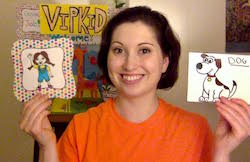
Lily Lewis. Photo courtesy of Lewis.
How’d you get into it? How long have you been doing it?
“I first heard about VipKid when several of my dancer friends raved about the job. They said it was fun, flexible and rewarding. I’ve been a teacher for 10 months now!”
What’s the time commitment?
“VipKid has created more time and funds for me to do what I love. The time commitment is like an Oreo cookie because you can teach mornings and evenings (if you so wish) and then have your afternoons free for class, auditions, time with friends and an occasional power nap. If there’s an audition in the morning, then I adjust my schedule to teach only at night. Likewise, if I am busy later in the day, then I only teach in the morning. It’s very flexible.”
How does being a VipKid tutor support you financially?
“During the interview process, you teach one or two mock classes for a VipKid Mentor, who then gives you recommendations on how to improve your class and answers questions you may have about the teaching process. It’s during your interview that a base pay per class is offered and negotiated. Another benefit of the job is saving time and money since you’re not commuting to work. Every night, I lay out my flashcards for my morning classes. I wake up 15 minutes before class to make coffee or tea, and then I sit down to teach.”
How do you balance dance with this job?
“It’s a very malleable job that can even work with a performance schedule. From May through September, I taught in the mornings while performing at night and was able to save money to support my acting, dance and vocal training.”
What’s your favorite part of the job?
“Working from home and building my own schedule have been very empowering. Since I make my schedule, I can give myself days off, I can go out of town to weddings and baby showers, I can see my friends and family in their shows, and I can audition more easily because I’m not worried about getting my shift covered if I’m called back later in the day or later in the week.”
Why do you like having a side hustle outside of the arts?
“Having a side job outside of theater reminded me of other interests I have that I was overlooking. Before I was a dancer, I was an artist. Growing up, I took drawing classes at the Columbus College of Art and Design. When I first started out as a teacher, I didn’t own a printer, so I drew all of my flashcards by hand. Designing my own classroom and props revived my love of drawing. Before VipKid, my previous teaching experience was in dance, and I wasn’t open to trying anything that would distract me from performing. Now that I am approaching my 500th class this week, I am more grounded, confident and joyful because I found a job I enjoy that nourishes other talents I possess and allows me to continuing training, auditioning and performing.”
Kaylee Olson (jewelry designer)
What’s your side hustle?
“I work for a jewelry company called Lizzie Fortunato Jewels. They sell high-end statement jewelry in boutiques and online. The products contain lots of natural materials, and everything is handmade, which is where I come in! I am hired as a contractor to make Lizzie’s designs. She first shows me how, then it is my job to reproduce anywhere from 20 to 200 pieces of that particular design.”
How’d you get into it? How long have you been doing it?
“I lucked into this job by answering an ad on Craigslist about seven years ago.”
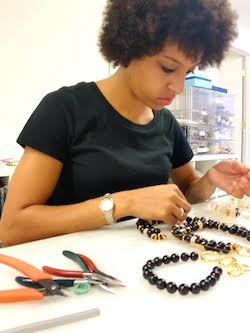
Kaylee Olson. Photo courtesy of Olson.
What’s the time commitment?
“I go into the office two to three times a week, depending on my audition or rehearsal schedule.”
How does the job support you financially?
“My pay is determined by piece. If a necklace is difficult or time-consuming, then I will get paid more for that piece. If I have ‘busy work’ (cutting chain, setting stones, repairs), then I am paid a decent hourly rate.”
How do you balance dance with this job?
“Fortunately, balancing dance with this job is pretty easy. My bosses are rooting for my career in the dance field. So long as I stay on task and complete my projects in a timely fashion, then I can come and go as my schedule of classes, auditions and gigs allows.”
What’s your favorite part of the job?
“My favorite part of the job is the work environment that I get to be a part of, and the work itself. I love creating things. It takes dedication, ingenuity and great care to create a beautiful piece of jewelry. And to have my efforts respected and valued by coworkers, supervisor and bosses makes it a really wonderful place to go work.”
Why do you like having a side hustle outside of the arts?
“I appreciate this ‘side hustle’ because I get to work with my hands, and it is still within the creative field. And the bonus — sitting in an office fiddling with beads is much easier on my body then dancing!”
Megan Peterson (fitness trainer)
What’s your side hustle?
“I’m an Orangetheory Fitness trainer.”
How’d you get into it? How long have you been doing it?
“I discovered Orangetheory Fitness while I was performing on tour. When I returned home, I began a membership. My local OTF was holding auditions for trainers, and I thought, ‘Why not?!’ Well, I booked it and have been coaching for almost two years!”
What’s the time commitment?
“Once you’re hired, there is quite a time commitment to get your certifications, pass all the corporate tests and train on the mic. Once that’s completed, the shifts are four to five hours a few times per week.”
How does the job support you financially?
“The pay is good. The bigger the class attendance, the better pay rate you get for that hour. Therefore, it’s important to form relationships with your clients and to really work as their motivator during the workout. The OTF workouts are predesigned for each month, so preparation is not overwhelming/time-consuming. You also don’t have to do your own marketing like an individual personal trainer might have to. There are lots of perks to being part of a larger company like OTF. Oh, you also get complimentary OTF classes!”
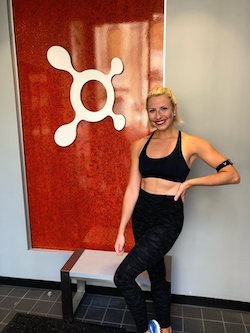
Megan Peterson. Photo courtesy of Peterson.
How do you balance dance with this job?
“I work weekend mornings and try to limit my weekday shifts since auditions usually take place at that time. This schedule works out, though, because most of the other trainers prefer to have their weekends ‘off’.”
What’s your favorite part of the job?
“The clients really enjoy seeing you bring your personality to class. I often play Broadway tunes from Hamilton or Grease and have even gone as far as singing a themed opening number to get everyone excited for class.”
Why do you like having a side hustle outside of the arts?
“I used to solely rely on dance. Expanding my horizons to musical theater and earning my BFA at Pace University helped me find my voice, my character, and a strong, healthy body. With all that achievement, this business comes with a lot of ‘nos’. I am grateful to have my side hustle and everything that it gives. Beyond the paycheck, the OTF workout, community and culture lifts me up on days when I’m struggling. It’s inspiring and fulfilling to come home to something that always says ‘yes!'”
Do you have a side hustle that supports your career as a dancer but doesn’t have anything to do with the performing arts? Share with us in the comments section below!
By Mary Callahan of Dance Informa.


